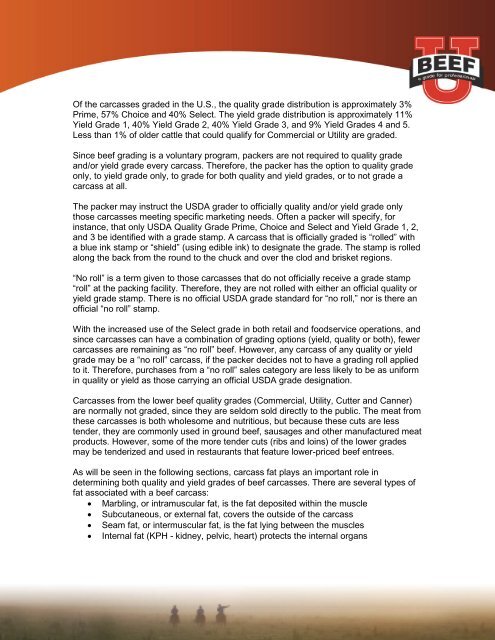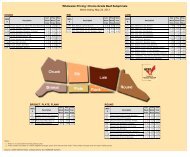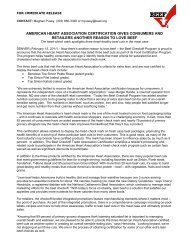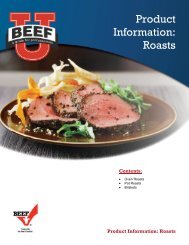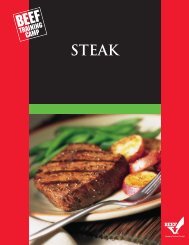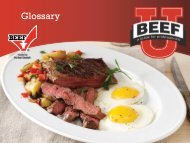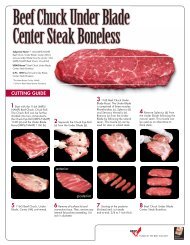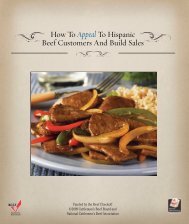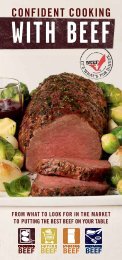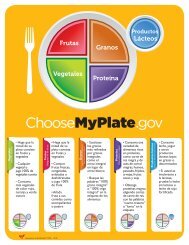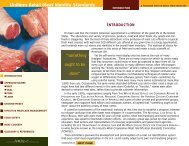Fact Sheet - Beef Foodservice
Fact Sheet - Beef Foodservice
Fact Sheet - Beef Foodservice
You also want an ePaper? Increase the reach of your titles
YUMPU automatically turns print PDFs into web optimized ePapers that Google loves.
Of the carcasses graded in the U.S., the quality grade distribution is approximately 3%<br />
Prime, 57% Choice and 40% Select. The yield grade distribution is approximately 11%<br />
Yield Grade 1, 40% Yield Grade 2, 40% Yield Grade 3, and 9% Yield Grades 4 and 5.<br />
Less than 1% of older cattle that could qualify for Commercial or Utility are graded.<br />
Since beef grading is a voluntary program, packers are not required to quality grade<br />
and/or yield grade every carcass. Therefore, the packer has the option to quality grade<br />
only, to yield grade only, to grade for both quality and yield grades, or to not grade a<br />
carcass at all.<br />
The packer may instruct the USDA grader to officially quality and/or yield grade only<br />
those carcasses meeting specific marketing needs. Often a packer will specify, for<br />
instance, that only USDA Quality Grade Prime, Choice and Select and Yield Grade 1, 2,<br />
and 3 be identified with a grade stamp. A carcass that is officially graded is “rolled” with<br />
a blue ink stamp or “shield” (using edible ink) to designate the grade. The stamp is rolled<br />
along the back from the round to the chuck and over the clod and brisket regions.<br />
“No roll” is a term given to those carcasses that do not officially receive a grade stamp<br />
“roll” at the packing facility. Therefore, they are not rolled with either an official quality or<br />
yield grade stamp. There is no official USDA grade standard for “no roll,” nor is there an<br />
official “no roll” stamp.<br />
With the increased use of the Select grade in both retail and foodservice operations, and<br />
since carcasses can have a combination of grading options (yield, quality or both), fewer<br />
carcasses are remaining as “no roll” beef. However, any carcass of any quality or yield<br />
grade may be a “no roll” carcass, if the packer decides not to have a grading roll applied<br />
to it. Therefore, purchases from a “no roll” sales category are less likely to be as uniform<br />
in quality or yield as those carrying an official USDA grade designation.<br />
Carcasses from the lower beef quality grades (Commercial, Utility, Cutter and Canner)<br />
are normally not graded, since they are seldom sold directly to the public. The meat from<br />
these carcasses is both wholesome and nutritious, but because these cuts are less<br />
tender, they are commonly used in ground beef, sausages and other manufactured meat<br />
products. However, some of the more tender cuts (ribs and loins) of the lower grades<br />
may be tenderized and used in restaurants that feature lower-priced beef entrees.<br />
As will be seen in the following sections, carcass fat plays an important role in<br />
determining both quality and yield grades of beef carcasses. There are several types of<br />
fat associated with a beef carcass:<br />
• Marbling, or intramuscular fat, is the fat deposited within the muscle<br />
• Subcutaneous, or external fat, covers the outside of the carcass<br />
• Seam fat, or intermuscular fat, is the fat lying between the muscles<br />
• Internal fat (KPH - kidney, pelvic, heart) protects the internal organs


